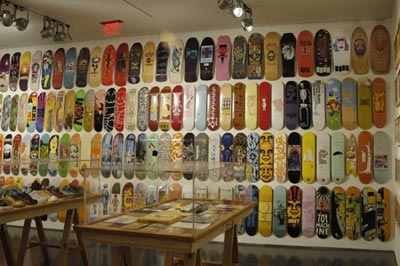
Skate decks, album covers and footwear, part of the Ephemera section of Beautiful Losers, Contemporary Art and Street Culture
Feature: Reviews
Beautiful Losers x 2
- Yerba Buena Center for the Arts and Orange County Museum of Art
- San Francisco and Newport Beach, California
- July 17- October 10, 2004 and February 6 - May 15, 2005
TAKE 1: Scott Hewicker
TAKE 2: Clark Buckner
Beautiful Losers: Contemporary Art and Street Culture
Yerba Buena Center for the Arts
July 17- October 10, 2004
Orange County Museum of Art
Newport Beach, California
February 6 - May 15, 2005
Lost: Beautiful Losers at YBCA
By Scott Hewicker
You would have either loved or hated the show Beautiful Losers, which closed recently at the Yerba Buena Center for the Arts and will be touring around the world through 2005. It had enough novelty and spectacle to entice curious tourists, and a legacy of street cred to attract youths (it helped to have a free indoor skate park nearby.) Plus there was just enough smutty disaffection to edge up the place a bit. So it’s no surprise that this show was a big hit. But if you’re not a tourist and not that young, this show may have taken on a different look and feel. Even if you are not familiar with this scene, this show felt about as fresh as Spin magazine.
Perhaps it’s the venue. YBCA has always felt like my dad trying to be cool. (You love the guy but stop trying so hard!) In trying to put a bubble around a culture with so many unique and individual tangents, motivations, and economic avenues, the curators established divisions that stifle this culture’s potential to evolve into something even fresher, inclusive and free-form. It’s all up for sale. Literally. The show felt like an ending.
For a scene and culture brewed up out of friendships, community and personal/professional connections, the layout of the show seemed surprisingly territorial and fussy. Sprawling wall murals peppered with clustered paintings clashed into each other (a popular aesthetic strategy these days, and perhaps one that should be given a little rest.) ¬†A lot of work looked like blown up advertisements. It also didn’t help that YBCA didn’t change the architecture of the space from the prior show, the Fela Kuti exhibit, so the layout in the main space looked the same, only much whiter.
Chris Johanson’s giant teepee structure with an interior multi-channel drum circle sound/ video piece and Jo Jackson’s pile of skulls with animated videos playing in the eyes gave the show much-needed breathing room. They were solid freestanding structures that were simple, dark, mysterious and playful. The photographs of Ed Templeton, Ryan McGinley and Terry Richardson were not as interesting in a gallery setting as they are in Vice magazine, where the photos make more sense as fantasy lifestyle examples for the buyers of advertised products. I was especially repulsed by (and oddly attracted to) Richardson’s gross, veiny hard-on and shit-eating grin that is in nearly all of his photographs.
It may not be fair to ask whether we need another show openly feeding off the enduring influence of Barry McGee. While McGee’s work (but not his presence) was very understated in Beautiful Losers, his long-deserved success is a catalyst for staging grand shows like this. This show has been a traveling success because it makes sense for it to be in places where these kinds of juxtapositions of art and culture are a novelty. But here in San Francisco, it just feels played.
SIMPARCH’s Free Basin, a companion piece to the Beautiful Losers exhibit, is the most inspired and successful installation I have seen at YBCA. It works on so many levels beyond that of street culture that I wish YBCA didn’t feel the need to somehow validate it by packaging it with such an overstated show.
That’s my biggest complaint about Beautiful Losers. There were many good artists in the show but you rarely see them showing with artists who don’t engage in similar methodologies and strategies or hang in different scenes. It felt tired. Will we ever be able to see Margaret Kilgallen’s work in a context outside of the scene she orbited in? Does her work only speak to that? Curating has got to take us further than this.
Yet this show is too easy to condemn on artistic merits, which is not really what the show is about at all. Friends of mine who are in the show know that a lot of people (especially artists not in the show, including me) will think the show is lame and they admit to being slightly embarrassed to be in it. They didn’t choose to be in the show because of the venue or because of the show itself. They were motivated by long friendships and by reconnecting with old acquaintances and that is what is seriously great, wonderful and essential about making and creating. Connecting with people. It’s not the artists’ fault that this show disappoints. It will help to like this show if you are connected with most of the people and lifestyles involved. You may also dig this show if you know nothing at all about this scene. But it’s problematic to be an insider and also an outsider. Ignorance is bliss.
By Clark Buckner
Beautiful Losers tests the boundaries between the museum and the street through an exploration of the influence of street-culture in art since the 1980s. Outside, in the windows both along Mission St. and at the entrance to the Yerba Buena Center for the Arts, one sees figures spray-painting the walls that reveal themselves only on second-glance to be mannequins in an untitled installation by Josh Lazcano and Barry McGee. Just inside, skateboard wheels thunder across Free Basin, a swimming pool sized skate-bowl constructed by the art-collective SIMPARCH; and skateboarders, typically relegated to thrashing the steps outside, wander the halls of the museum wearing helmets. On one wall of the front gallery hangs Money to Loan a billboard-sized painting by Margaret Kilgallen that might just as well be found in the Mission’s Clarion Alley. And the show is rich with photo-documents of graffiti projects, including Brian Donnelly’s (aka KAWS) manipulation of telephone booth and bus-stop posters.
With styles drawn from hip-hop, comic books, and punk, the show establishes a clear connection between street-culture and adolescent rebellion—revealing street art to be produced largely by young people without private spaces of their own, and identifying this defiant energy to be the principal source of its inspiration in contemporary art. Terry Richardson’s pornographic photographs bear the mark of this Oedipal conflict through his obvious enjoyment of their deviance. And Chris Johanson entertains an unreserved childishness in his untitled installation, which presents a cacaphonous circle of video-monitors mounted in a wooden mock-up of a teepee, with adults dressed in monotone jumpers banging chaotically on drums against crayon-colored backgrounds. Johanson’s piece is hilarious (if somewhat silly) and presents a welcome departure from the didactic moralizing, which plagues so much of his painting.
But the emphasis on youth-culture degenerates into mere hipsterism in the work of artists such as Ryan McGinley and pro-skater turned artist Ed Templeton, who present pictures of their purportedly counter-cultural cohorts as if their rock-and-roll lifestyles were enough to make the work compelling. And the work of Templeton and others for corporations including Nike, Geffen Records, and the Gap raises questions concerning street-art’s pretenses to authenticity and the commerce of cool that fuels contemporary capitalism.
(2) COMMENTS
No mention of the fact that nearly all the artists were men? And the only women in the show are intimately related to male artists in the show? I thought that was a pretty obvious oversight on behalf of the curators.

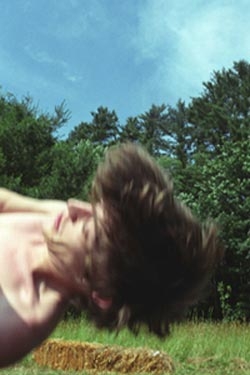
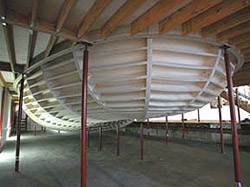
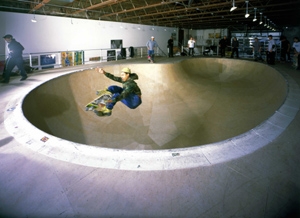
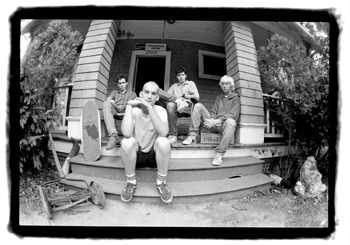
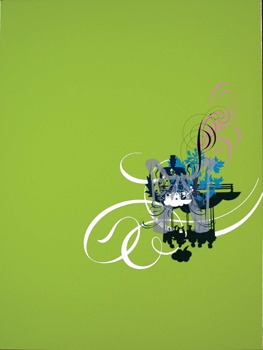
Ryan McGuinness and Ryan McGinley? Rilly?
Ambitious Outsiders (2003), Ryan McGuinness, enamel on wood panel, 72” x 48” Courtesy of the artist and Deitch Projects, New York
But the emphasis on youth-culture degenerates into mere hipsterism in the work of artists such as Ryan McGinley and pro-skater turned artist Ed Templeton, who present pictures of their purportedly counter-cultural cohorts as if their rock-and-roll lifestyles were enough to make the work compelling. And the work of Templeton and others for corporations including Nike, Geffen Records, and the Gap raises questions concerning street-art’s pretenses to authenticity and the commerce of cool that fuels contemporary capitalism.
sar • September 21, 2004